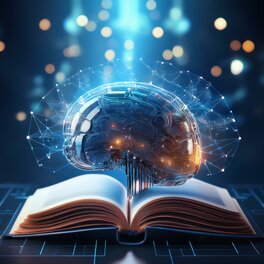Accessibility Options:
Welcome
 Welcome to the Artificial Intelligence Research Guide! Artificial Intelligence (AI) is a field dedicated to developing computers and robots capable of imitating the human mind. The term “AI” was coined by John McCarthy during a 1956 summer workshop at Dartmouth University. However, many technical concepts that define AI predate this period. Alan Turing’s theoretical ideas significantly influenced future AI research.
Welcome to the Artificial Intelligence Research Guide! Artificial Intelligence (AI) is a field dedicated to developing computers and robots capable of imitating the human mind. The term “AI” was coined by John McCarthy during a 1956 summer workshop at Dartmouth University. However, many technical concepts that define AI predate this period. Alan Turing’s theoretical ideas significantly influenced future AI research.
Since 1956, AI has evolved, and more recently, there has been a surge in its use, particularly with the creation of ChatGPT in spring 2023. While the exact future of AI remains uncertain, it is undeniable that AI will most likely continue to impact every aspect of our lives. This guide provides information on starting your AI research, with available resources at the University of Miami Libraries and beyond.
The University of Miami Libraries are here to support your exploration of AI resources. Whether you're a beginner, novice, or expert AI user, we're here to help. If you have questions or need personalized assistance, don’t hesitate to connect with a Subject Librarian.
*Portions of this research guide were created using Microsoft Copilot or Adobe Firefly.
References
Appendix I: A short history of AI | One hundred year study on artificial intelligence (AI100). (n.d.). Retrieved July 26, 2024, from https://ai100.stanford.edu/2016-report/appendix-i-short-history-ai
Artificial Intelligence (AI) vs. Machine Learning. (n.d.). CU-CAI. Retrieved July 26, 2024, from https://ai.engineering.columbia.edu/ai-vs-machine-learning/
Librarian
-

Erica Newcome
STEM and Interdisciplinary Research Librarian
she/her
305-284-4059
-
AI Glossary
Algorithm: a sequence of steps to be followed in calculations or other problem-solving operations.
Artificial Intelligence (AI): technology that allows computers and machines that can think and make decisions autonomously without human intervention.
ChatGPT: natural language processing chatbot powered by generative AI that enables human-like conversations to complete tasks.
Deep Learning: subset of machine learning that utilizes multi-layered neural networks to simulate the human brain's ability to perform complex decision-making.
Generative AI: a category of artificial intelligence that can create new data that mimic a given set of training data and can produce outputs such as images, music, texts, and videos.
GPT (Generative Pre-trained Transformers): an artificial intelligence (AI) tool that can produce clear, coherent, human-like text and computer code in response to a question or prompt submitted by a user.
Hallucination: a large language model (LLM) perceives patterns or objects that are nonexistent or imperceptible to human observers, creating outputs that are nonsensical or altogether inaccurate.
Large Language Model (LLM): a category of foundation models trained on immense amounts of data making them capable of understanding and generating natural language and other types of content to perform a wide range of tasks.
Machine Learning (ML): a subfield of artificial intelligence that uses algorithms trained on data sets to create models that enable machines to perform tasks that would otherwise only be possible for humans, such as categorizing images, analyzing data, or predicting price fluctuations.
Natural Language Processing (NLP): a form of artificial intelligence (AI) that allows computers to understand human language, whether it be written, spoken, or even scribbled.
Prompt: a question, command, or statement that you input into an AI model to initiate a response or action.
Prompt Engineering: the process of iterating a generative AI prompt to improve its accuracy and effectiveness.
Reinforcement Learning: A type of dynamic programming that trains algorithms using a system of reward and punishment. In reinforcement learning, an agent takes actions in a specific environment to achieve a predetermined goal, learning from the outcomes of its actions to maximize cumulative rewards.
Self-Supervised Machine Learning: A type of machine learning where models train themselves on unlabeled data. This approach, also known as predictive or pretext learning, allows algorithms to learn one part of the input from another part, automatically generating labels and transforming unsupervised problems into supervised ones.
Semi-Supervised Learning: A type of machine learning that combines elements of both supervised and unsupervised learning. It involves training algorithms on a small labeled dataset and a larger unlabeled dataset. The labeled data helps guide the learning process for the unlabeled data, making it useful for tasks where labeling data is expensive or time-consuming.
Supervised Machine Learning: A type of machine learning where the model is trained on a labeled dataset. This approach is commonly used for tasks such as risk assessment, image recognition, predictive analytics, and fraud detection.
Unsupervised Machine Learning: A type of machine learning where algorithms draw inferences from unlabeled datasets. This approach is used for exploratory data analysis, pattern recognition, and predictive modeling.
References
Artificial intelligence (AI) algorithms: A complete overview | Tableau. (n.d.). Retrieved June 3, 2024, from https://www.tableau.com/data-insights/ai/algorithms
Artificial intelligence tools at the U | University of miami information technology. (n.d.). Retrieved June 3, 2024, from https://it.miami.edu/about-umit/resources/ai-tools/index.html
ChatGPT | Definition & facts | Britannica. (n.d.). Retrieved June 3, 2024, from https://www.britannica.com/technology/ChatGPT
Facebook, V. S. S. at, Instagram, V. S. S. at, LinkedIn, V. S. S. at, X, V. S. S. at, Flickr, V. S. S. at, Youtube, V. S. S. at, TikTok, V. S. S. at, University, C. S., Compliance, Safety, C., Statement, A., Statement, P., IX, T., & Comments. (n.d.). Glossary of AI terms. Retrieved June 3, 2024, from https://www.csus.edu/information-resources-technology/ai/glossary-of-ai-terms.html
Introducing ChatGPT. (n.d.). Retrieved June 3, 2024, from https://openai.com/index/chatgpt/?ref=blog-what-is-chat-gpt-understanding¶ms=ref-blog-what-is-chat-gpt-understanding
TLS, U. L. (n.d.). LibGuides: Artificial intelligence (AI): Introduction. Retrieved June 3, 2024, from https://guides.lib.utexas.edu/c.php?g=1363366&p=10070740
What are AI hallucinations? | IBM. (2023, September 1). https://www.ibm.com/topics/ai-hallucinations
What are AI prompts? (& How to make them better) | Copy.ai. (n.d.). Retrieved June 3, 2024, from https://www.copy.ai/blog/what-are-ai-prompts
What are large language models (LLMs)? | IBM. (2023, November 2). https://www.ibm.com/topics/large-language-models
What is ChatGPT? (n.d.). Retrieved June 3, 2024, from https://www.brandeis.edu/teaching/chatgpt-ai/index.html
What is ChatGPT and why does it matter? Here’s what you need to know. (n.d.). ZDNET. Retrieved June 3, 2024, from https://www.zdnet.com/article/what-is-chatgpt-and-why-does-it-matter-heres-everything-you-need-to-know/
What is generative AI? | IBM. (2024, March 22). https://www.ibm.com/topics/generative-ai
What is machine learning? Definition, types, and examples. (2024, March 27). Coursera. https://www.coursera.org/articles/what-is-machine-learning
What is natural language processing? Definition and examples. (2024, March 19). Coursera. https://www.coursera.org/articles/natural-language-processing
Introduction
Use the below databases and eJournals to search for articles regarding Artificial Intelligence.
Databases
ACM Digital Library
Full-text access to a variety of journals and conference proceedings published by the Association for Computing Machinery. Note: The Richter Library subscription does not include full text access to the ACM Proceeding and SIG newsletter articles.
CiteSeerX
Evolving scientific literature digital library and search engine.
IEEE Xplore Digital Library
Full-text access to journals, conference proceedings and active standards published by IEEE and IET
Knovel Library
An online reference shelf including handbooks, dictionaries and datasets covering the full range of engineering disciplines; also includes biochemical, biology and chemistry reference resources
SCOPUS
Covering the life, physical, health, and social sciences, Scopus is a large abstract and citation database of research literature and web sources.
Web of Science, published by Thomson Reuters, is a multi-disciplinary database that provides integrated access to over 8,000 key research journals indexed in: Science Citation Index Expanded, Social Science Citation Index, and Arts and Humanities Citation Index.
Created with Microsoft Copilot

eJournals
Artificial intelligence in medicine
Original articles from a wide variety of interdisciplinary perspectives concerning the theory and practice of artificial intelligence (AI) in medicine, human biology, and health care.
Computers and education
Journal that aims at affording a world-wide platform for researchers, developers, and educators to present their research studies, exchange new ideas, and demonstrate novel systems and pedagogical innovations on the research topics in relation to applications of artificial intelligence (AI) in education and AI education.
Discover artificial Intelligence
Journal on Artificial intelligence and Computational linguistics.
Journal of artificial intelligence
Research reports and critical evaluations of applications, techniques and algorithms from artificial intelligence, cognitive science and related disciplines.
Journal of artificial intelligence research
Journal on Artificial intelligence.
Journal of experimental & theoretical artificial intelligence
World leading journal dedicated to publishing high quality, rigorously reviewed, original papers in artificial intelligence (AI) research
Journal of robotics, artificial intelligence & law
First legal journal focused exclusively on exploring how robotics and machine learning are impacting our world.
Created with Microsoft Copilot

About
 Tools listed below are either free, freemium, or accessible via subscription for University of Miami faculty and staff. You can also view the Generative AI Product Tracker which lists generative AI products that are either marketed specifically towards postsecondary faculty or students or appear to be actively in use by postsecondary faculty or students for teaching, learning, or research activities.
Tools listed below are either free, freemium, or accessible via subscription for University of Miami faculty and staff. You can also view the Generative AI Product Tracker which lists generative AI products that are either marketed specifically towards postsecondary faculty or students or appear to be actively in use by postsecondary faculty or students for teaching, learning, or research activities.
Find a listing of UM enterprise AI tools at AI Tools at the U.
Disclaimer: The tools included in this guide are intended to provide an overview of various AI tools that may be beneficial for university students, faculty, and staff. The inclusion of any specific tool does not constitute an endorsement. Users are encouraged to independently verify the suitability, reliability, and appropriateness of each tool for their specific needs. You can also use the vetting system (VALID-AI) at the University of Toronto when evaluating an AI tool.
Tools
- Goblin Tools: Tools mostly designed to help neurodivergent people with difficult tasks.
- SlidesAI: Create Presentation Slides with AI in seconds.
- Slidesgo: With a few clicks, you’ll have wonderful slideshows that suit your own needs.
- SlideSpeak: Create presentations with AI, summarize PowerPoint or Word documents and much more.
- MathGPT: Created by current Cornell students, it provides instant homework help from an on-demand AI math solver.
- Elicit: Search, summarize, extract data from, and chat with over 125 million papers.
- Google Notebook LLM: Research and notetaking assistant that allows for uploaded documents to generate source-cited summaries, explanations, and audio overviews.
- Heuristica: AI-powered mind maps and concept maps for visual learning, thinking and research.
- Perplexity: Uses natural language processing and machine learning to generate responses from a variety of reputable sources, citing links within the text.
- ResearchRabbit: A scholarly publication discovery tool supported by AI.
- SCISPACE: Save parts of a PDF or Copilot response as notes.
- Undermind: AI-powered research assistant that autonomously reads and analyzes hundreds of academic papers.
- DeepL Translator: Translates texts & full document files.
- Google Translate: Instantly translates words, phrases, and web pages between English and over 100 other languages.
Start
Prompt Engineering is the process of iterating a generative AI prompt to improve its accuracy and effectiveness. Think of prompt engineering like giving really good directions. It’s like telling your friend exactly how to get to a party, including where to turn and what landmarks to look out for. In the same way, you give an AI clear instructions on what you want it to do or say. You have to be specific, like saying “take a left at the big palm tree” instead of just “go that way.” This helps the AI understand and give you exactly the kind of answer or help you’re looking for.
Guideline for creating a prompt
The CLEAR framework is a set of principles designed to improve the interaction with AI through prompt engineering. It stands for Concise, Logical, Explicit, Adaptive, and Reflective.
- Concise
- Be Direct: Use clear and straightforward language.
- Eliminate Fluff: Remove unnecessary words that don’t add value to the prompt.
- Logical
- Order Matters: Structure your prompts in a logical sequence.
- Step-by-Step: Break down complex tasks into simpler steps.
- Explicit
- Be Specific: Clearly state what you want the AI to do.
- Avoid Assumptions: Don’t expect the AI to “read between the lines.”
- Adaptive
- Flexibility: Be ready to adjust your prompts based on the AI’s responses.
- Iterative Approach: Refine your prompts through trial and error.
- Reflective
- Feedback Loop: Use the AI’s responses to reflect on the effectiveness of your prompts.
- Continuous Improvement: Aim to improve the clarity and efficiency of your prompts over time.
*Created using Microsoft Copilot
Prompting AI from Wharton School
Undergraduate Honor Code Plagiarism Definition
"is representing the words or ideas of someone else as your own. Examples include, but are not limited to, failing to properly cite direct quotes and failing to give credit for someone else's ideas."
Principles from UM PETAL Regarding AI
- AI should help you think, not think for you. AI tools may be used to help generate ideas, frame problems, and perform research. It can be a starting point for your own thought process, analysis, and discovery. Do not use them to do your work for you, e.g., do not enter an assignment question into ChatGPT and copy and paste the response as your answer.
- The use of AI must be open and documented. The use of any AI in the creation of your work must be declared in your submission and explained. Your faculty can provide guidance as to the format and contents of the disclosure. The undeclared use of any AI (including text, images, program code, musical notation, etc) in any work may be considered as plagiarism.
- Engage with AI Responsibly and Ethically. Engage with AI technologies responsibly, critically evaluating AI-generated outputs and considering potential biases, limitations, and ethical implications in your analysis and discussions. Ensure that the data used for AI applications are obtained and shared responsibly. Never pass off as your own work generated by AI.
- You are 100% responsible for your final product. You are the user; if the AI tool makes a mistake, and you use it, then it’s your mistake. If you don’t know whether a statement about any item in the output is true, then it is your responsibility to research it. If you cannot verify it as factual, you should delete it. You hold full responsibility for AI-generated content. Ideas must be attributed, and sources must be verified.
- These principles are in effect unless the instructor gives you specific guidelines for an assignment or exam. It is your responsibility to ensure you are following the correct guidelines. Not following them will result in a breach of the Academic Integrity Policy.
- Data that are confidential or personal should not be entered into generative AI tools. Putting confidential or personal data into these tools exposes you and others to the loss of important information. Therefore, do not do so. See point 3 above.
- The rules and practices on the use of AI may vary from class to class, discipline to discipline. Do not assume that what is acceptable in a Computer Science class will be acceptable in a Philosophy class. It is the student’s responsibility to stay informed as to the instructor’s expectations. When in doubt, ask.
Introduction
In academia, researchers must remain vigilant when using AI, considering both its potential benefits and downsides. By addressing these challenges, you can harness AI’s power while minimizing its risks. This tab is dedicated to describing the disadvantages associated with artificial intelligence.
While AI has amazing capabilities, it’s essential to recognize its negative aspects such as:
- Bias
- Environmental Impact
- Hallucinations
- Labor
- Privacy
Bias

Users should be aware of the different biases in AI:
- Selection Bias
- When the participants selected for a study are not representative of the target population, often due to non-random sampling or retention methods. This can lead to skewed results and inaccurate conclusions.
- Confirmation Bias
- Confirmation bias is the tendency to seek out, interpret, and favor information that confirms one’s pre-existing beliefs or hypotheses. This bias can lead to flawed decision-making and reinforce existing misconceptions.
- Measurement/Information Bias
- Occurs when key study variables are inaccurately measured or classified, leading to systematic errors in the study’s results. This bias can significantly distort the association between variables and affect the study’s validity.
- Stereotyping Bias
- Involves forming generalized beliefs or assumptions about individuals based solely on their membership in a particular group, often ignoring their unique characteristics. This cognitive bias can lead to unfair treatment and reinforce existing prejudices.
- Out-group homogeneity bias
- Tendency to perceive members of an out-group as more similar to each other than members of one’s in-group, often overlooking individual differences. This bias can lead to stereotyping and misjudgments about out-group members.
Environmental Impact
 Artificial Intelligence (AI) demands significant energy, necessitating numerous servers in data centers, which in turn require substantial power. This leads to various environmental impacts, including:
Artificial Intelligence (AI) demands significant energy, necessitating numerous servers in data centers, which in turn require substantial power. This leads to various environmental impacts, including:
- High Water Consumption: Data centers consume large amounts of water to cool servers.
- Air Pollution: Increased energy use can lead to higher emissions of air pollutants.
- High Energy Use: This often results in greater reliance on fossil fuels, contributing to greenhouse gas emissions.
- Inefficient Resource Use: The operation of data centers can lead to inefficient use of natural resources.
- E-Waste: The rapid advancement of technology can increase electronic waste
Hallucinations
 AI hallucinations refer to instances where artificial intelligence systems generate outputs that are false or inaccurate, often due to limitations in their training data or inherent design flaws. These hallucinations can undermine the reliability of AI tools. To combat AI hallucinations:
AI hallucinations refer to instances where artificial intelligence systems generate outputs that are false or inaccurate, often due to limitations in their training data or inherent design flaws. These hallucinations can undermine the reliability of AI tools. To combat AI hallucinations:
- Critically Evaluate Outputs: Always assess the information provided by AI critically.
- Diversify Sources: Use a variety of sources to cross-check and validate AI outputs.
- Stay Vigilant: Remain alert and cautious when interpreting results from any AI tool.
Note: While the term "hallucination" is commonly used in the AI industry, there are concerns that the phrase can possibly be undermining the "efforts to reduce stigma in psychiatry and mental health."
Labor
 Artificial Intelligence (AI) is reshaping the labor market in profound ways, presenting both opportunities and challenges. On one hand, AI can enhance productivity and create new job categories, particularly in technology-driven sectors. However, it also poses the risk of job displacement, as AI systems can perform tasks traditionally done by humans, potentially leading to lower labor demand, wage reductions, and less hiring. This dual impact is more pronounced in routine tasks susceptible to automation, while jobs requiring complex problem-solving and creative skills may see growth. The integration of AI into the workplace can exacerbate existing inequalities, as those with higher education and specialized skills may be better positioned to benefit from AI, leaving less-skilled workers vulnerable.
Artificial Intelligence (AI) is reshaping the labor market in profound ways, presenting both opportunities and challenges. On one hand, AI can enhance productivity and create new job categories, particularly in technology-driven sectors. However, it also poses the risk of job displacement, as AI systems can perform tasks traditionally done by humans, potentially leading to lower labor demand, wage reductions, and less hiring. This dual impact is more pronounced in routine tasks susceptible to automation, while jobs requiring complex problem-solving and creative skills may see growth. The integration of AI into the workplace can exacerbate existing inequalities, as those with higher education and specialized skills may be better positioned to benefit from AI, leaving less-skilled workers vulnerable.
Privacy
 The integration of Artificial Intelligence (AI) into various aspects of daily life has raised significant privacy concerns. One of the primary issues is the scale of data collection; AI systems require vast amounts of data to learn and improve, leading to an unprecedented level of personal data being harvested and analyzed. This often occurs without explicit user consent or awareness, resulting in a loss of control over personal information. Additionally, there’s the risk of reidentification and deanonymization, where AI can potentially track and identify individuals across multiple platforms, breaching the users' expectation of anonymity.
The integration of Artificial Intelligence (AI) into various aspects of daily life has raised significant privacy concerns. One of the primary issues is the scale of data collection; AI systems require vast amounts of data to learn and improve, leading to an unprecedented level of personal data being harvested and analyzed. This often occurs without explicit user consent or awareness, resulting in a loss of control over personal information. Additionally, there’s the risk of reidentification and deanonymization, where AI can potentially track and identify individuals across multiple platforms, breaching the users' expectation of anonymity.
HIPAA
"the generative AI tool ChatGPT is not HIPAA compliant, and the University does not permit its use with any patient data. OpenAI, the company behind ChatGPT, also warns against inputting confidential data into the platform, which could constitute a public disclosure and lead to a loss in our ability to protect University information, including intellectual property." -Artificial Intelligence Tools at the U
"Copilot is not HIPAA compliant yet." -Artificial Intelligence Tools at the U
AI Detectors
"The use of systems that claim to detect AI-generated text (e.g. GPTZero, Copyleaks) are not recommended. Submitting students’ coursework to these systems may constitute a FERPA violation since students’ work is considered an educational record." -PETAL
Citing your AI Sources
 Citing sources is an essential activity in academia and provides proper credit to authors. It allows your reader to find sources you used and also helps combat plagiarism. Citing AI is just as important as citing any other source.
Citing sources is an essential activity in academia and provides proper credit to authors. It allows your reader to find sources you used and also helps combat plagiarism. Citing AI is just as important as citing any other source.
Note: A majority of the text below is copied from APA , APA Style, The Chicago Manual of Style Online, and the MLA Style Center.
APA Guideline
- When a generative AI model is used in the drafting of a manuscript for an APA publication, the use of AI must be disclosed in the methods section and cited.
- AI cannot be named as an author on an APA scholarly publication.
- When AI is cited in an APA scholarly publication, the author must employ the software citation template, which includes specifying in the methods section how, when, and to what extent AI was used. Authors in APA publications are required to upload the full output of the AI as supplemental material
APA Format Examples
References: OpenAI. (2023). ChatGPT (Mar 14 version) [Large language model]. https://chat.openai.com/chat
In-text example: (OpenAI, 2024)
Chicago Guideline
- Credit AI-generated text when you reproduce its words within your own work.
- "You do need to credit ChatGPT and similar tools whenever you use the text that they generate in your own work. But for most types of writing, you can simply acknowledge the AI tool in your text (e.g., “The following recipe for pizza dough was generated by ChatGPT”).
Chicago Format Example
Text generated by ChatGPT, OpenAI, March 7, 2023, https://chat.openai.com/chat.
MLA Guideline
- Cite a generative AI tool whenever you paraphrase, quote, or incorporate into your own work any content (whether text, image, data, or other) that was created by it.
- Acknowledge all functional uses of the tool (like editing your prose or translating words) in a note, your text, or another suitable location.
- Take care to evaluate the secondary sources it cites.
- It is not recommended to treat the AI tool as an author.
MLA Format examples
-
Paraphrased in Your Prose: While the green light in The Great Gatsby might be said to chiefly symbolize four main things: optimism, the unattainability of the American dream, greed, and covetousness (“Describe the symbolism”), arguably the most important—the one that ties all four themes together—is greed.
-
Works-Cited-List Entry: “Describe the symbolism of the green light in the book The Great Gatsby by F. Scott Fitzgerald” prompt. ChatGPT, 13 Feb. version, OpenAI, 8 Mar. 2023, chat.openai.com/chat.
-
Creative Visual Works: Fig. 1. “Pointillist painting of a sheep in a sunny field of blue flowers” prompt, DALL-E, version 2, OpenAI, 8 Mar. 2023, labs.openai.com/.
-
Quoting Creative Textual Works: “The Sunflower” villanelle about a sunflower. ChatGPT, 13 Feb. version, OpenAI, 8 Mar. 2023, chat.openai.com/chat.
Introduction
Artificial Intelligence (AI) is revolutionizing the landscape of education, offering innovative tools and methods to enhance both teaching and learning experiences. This research guide aims to explore the multifaceted applications of AI in education. It provides educators with ideas on how AI can be effectively integrated into educational practices to foster a more engaging, efficient, and inclusive learning environment.
Platform for Excellence in Teaching and Learning (PETAL)
Tools
Generative artificial intelligence chatbot developed by Microsoft.
Helps you seamlessly administer and grade all of your assessments.
Lists generative AI products that are either marketed specifically towards postsecondary faculty or students or appear to be actively in use by postsecondary faculty or students for teaching, learning, or research activities.
Syllabus
Developing an AI Syllabus Statement & Driving Class AI Discussion (NCSU)
Developing Syllabus Statements for AI (Tufts University)
Possible AI Syllabus Statements (Brandeis University)
Instruction
PETAL's View on AI Text Detectors
"The use of systems that claim to detect AI-generated text (e.g. GPTZero, Copyleaks) are not recommended. Submitting students’ coursework to these systems may constitute a FERPA violation since students’ work is considered an educational record."
Articles
Books
Video from USF on Creating a GenAI Policy
Curious about how to use AI effectively and responsibly for your class or research?
Support is available from University of Miami Libraries to help you navigate AI resources with confidence and integrity. Explore the other tabs of this guide to discover AI tools and resources avaliable to you. If you have more questions or need help, don’t hesitate to reach out to a Subject Librarian.
Video


